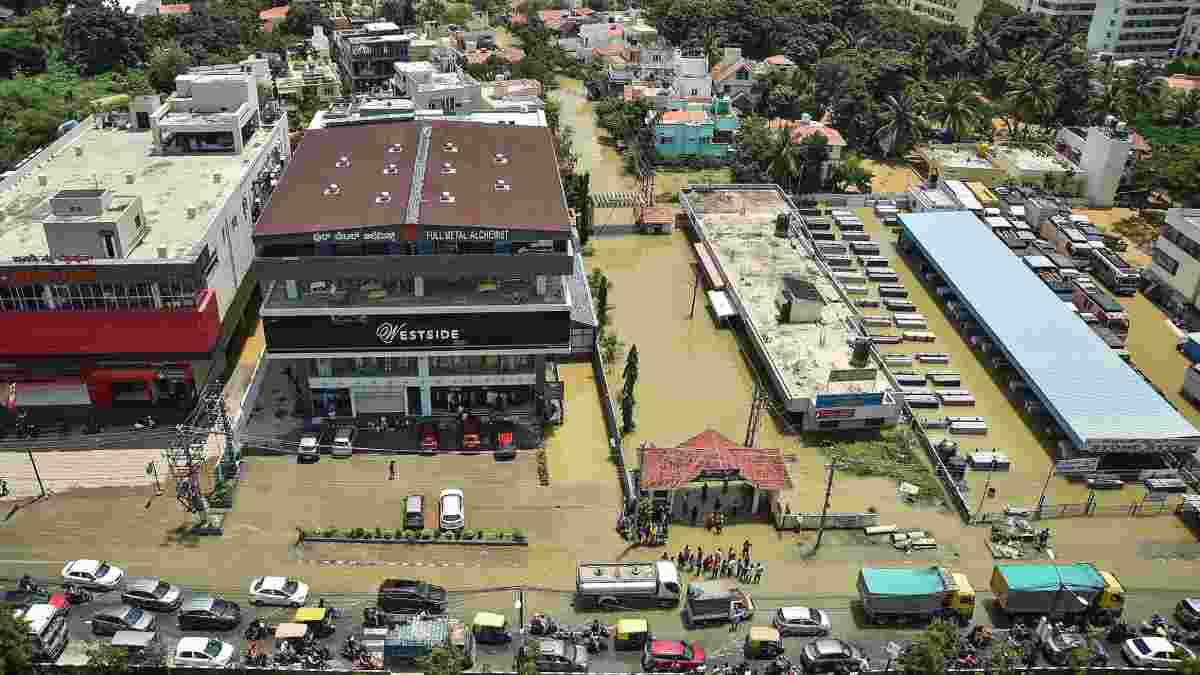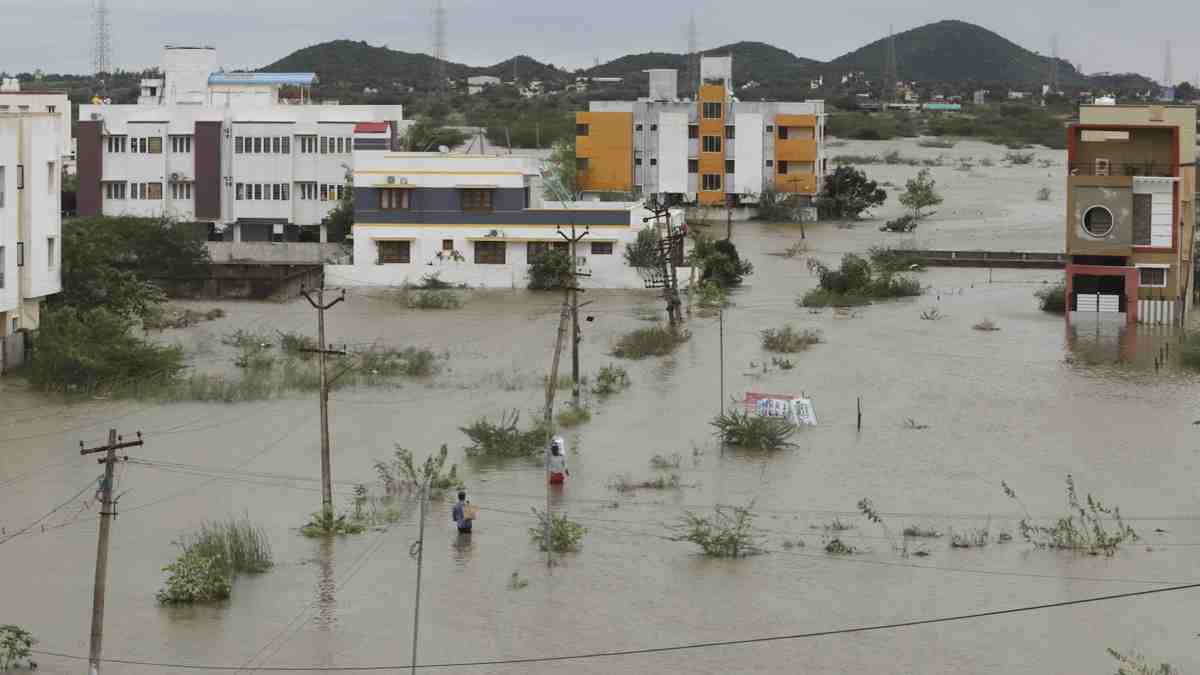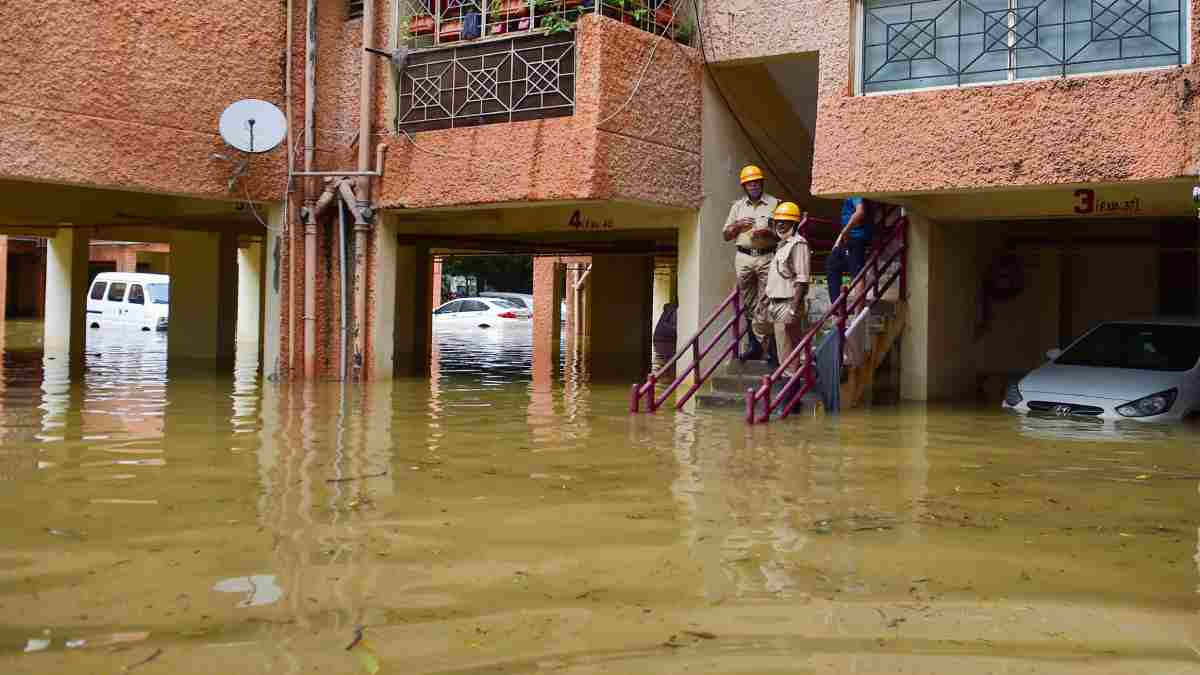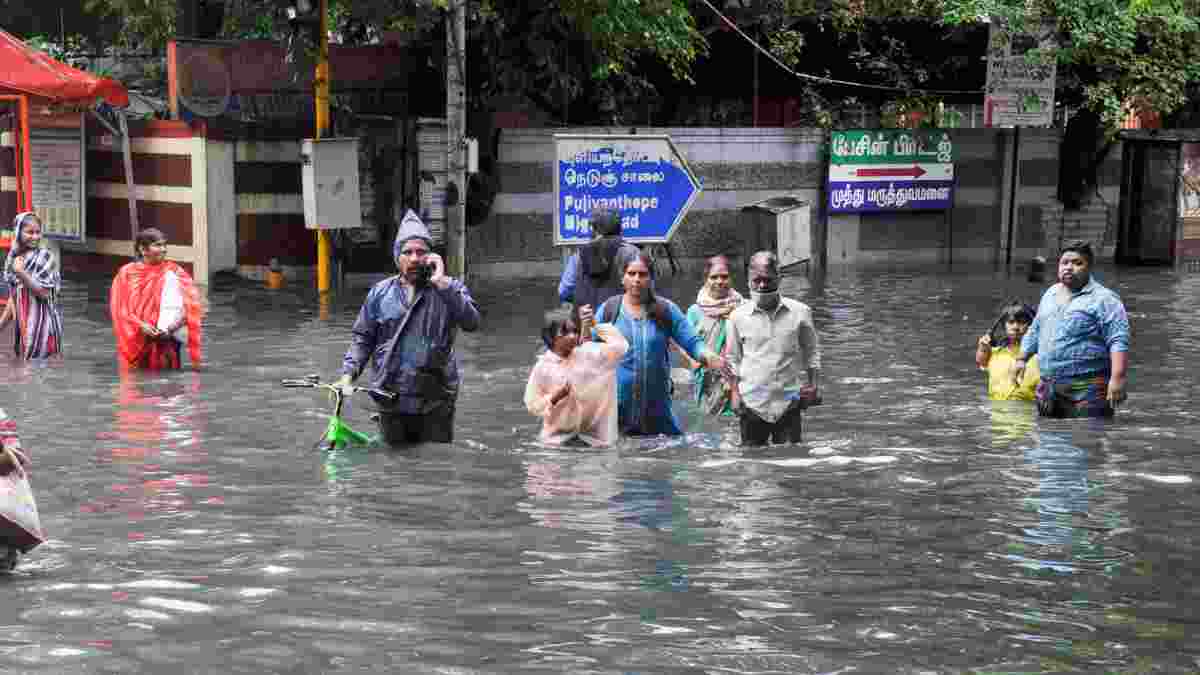
What is Urban Flooding? How is Bengaluru at the High Risk because of Mocha?
When city landscapes are unable to absorb surplus water following lengthy periods of extreme rainfall, river overtopping, or storm surge, Urban Flooding occurs. Environmental changes have already increased flooding in the United States, particularly in coastal and low-lying areas.
What Bengaluru Floods 2022 taught us Climate change impacts have been increasing every year across the world, with even more intensity and frequency. Unprecedented floods in Bangladesh, followed by Assam floods, extremely heavy rains in Madhya Pradesh adjoining parts of Rajasthan, Pakistan floods, and the latest being Bengaluru floods.

All the aforesaid incidents have shown how the quantum of extreme events has increased exponentially in South Asia.
The UN’s Intergovernmental Panel on Climate Change (IPCC) had already warned last year about the increase in extreme weather events across South Asia in the coming years if the emissions continue to be unchecked. Asian urban areas are considered high-risk locations from projected climate change, extreme events, unplanned urbanization, and rapid land-use change.
With increasing urbanization, our cities are at greater risk as the volume of damage in terms of loss of human lives, property damage, and economic losses are higher than in rural areas. Cities like Mumbai, Kolkata, Bengaluru, Delhi, and Chennai are home to millions of people and so high is the climate risk.

Asia is home to 54% of the world’s urban population, and by 2050, 64% of Asia’s 3.3 billion people will be living in cities. Asia is also home to the world’s largest urban agglomerations: Tokyo (37 million inhabitants), New Delhi (29 million) and Shanghai (26 million) are the top three with Cairo, Mumbai, Beijing, and Dhaka home to nearly 20 million people each. By 2028, New Delhi is projected to become the most populous city in the world.
In the warming environment, urban flooding is a major threat to our cities and towns. Regional ecological challenges coupled with climatic variability have aggravated flood risks. Urban flooding which was primarily a concern of municipal and environmental governance, has now attained the status of ‘disaster’.
What is Urban Flooding?
Urban flooding can be defined as a combination of two factors, mismanagement of urban planning and climate change impacts which are intensifying and becoming more frequent. In extreme cases, urban floods can result in disasters that set back urban development for years or even decades.
According to the IPCC, warming from 1.5°C to 2°C will increase extreme precipitation events across Asia, especially over East and South Asia. Extreme rainfall has direct and increasing consequences on urban flooding risk, which is further exacerbated by urbanization trends that reduce land permeability, divert water flow, and disrupt watersheds.
Mumbai floods in 2005 can be termed as the first example of urban flooding, which brought the focus of experts and the government on it. Urban flooding has been recognized as a ‘disaster’ only after the Mumbai flood in 2005. The flood of 2005 was truly a disaster as it receded only after seven weeks and affected 20 million people. On July 26, 2005, the city recorded 944 mm in a span of 18 hours, out of which maximum rainfall of 647.5 mm was recorded between 14.30 and 20.30 hrs.
The floods killed 1200 people and 26,000 cattle. It destroyed more than 14,000 homes, and damaged more than 350,000; about 200,000 people had to stay in relief camps. The agricultural sector was heavily hit as 20,000 ha of farmland lost the topsoil and 550,000 ha of the crop was damaged.
Bengaluru floods of 2022 are the latest example, where India’s IT hub reportedly registered a loss of over Rs 225 crores. The city recorded 132 mm of rain in a span of 24 hours on September 5, which accounts for 10% of the seasonal rainfall. This was the wettest day since September 26, 2014. While changes in Monsoon systems due to climate change led to torrential rains over the city, the situation worsened due to poor urban planning which did not let the water find its way out, eventually inundating it for days.

With the increasing frequency and intensity of extreme weather events, this can be more recurrent across Indian cities, impacting lives, livelihoods, and GDP.
Bengaluru was known as the city of lakes, which acted as rescuers from floods as well as droughts. The intense urbanization process led to the encroachment of wetlands, floodplains, etc. causing floodway obstruction.
With the loss of natural flood storage in Bengaluru, flooding had worsened by unauthorized developments along the lakes. In the wake of urbanization, the network between the water bodies is completely broken, making them independent entities. Choked drains led to residential parts of the city being inundated. It demonstrated how unplanned, rapid urban development has stretched the natural ecosystems in and around a city to its limits, and made disaster from natural flood hazards inevitable and more destructive.
“Urbanisation across the city continues to be unchecked, maximizing on the most the city has. Bengaluru is doing nothing to adapt. Political system and will is not aligned with climate resilient policy. In fact, there has been no political stability to battle climate risk as 15 chief ministers have changed in the last 20 years,” Dr. Anjal Prakash, Research Director and Adjunct Professor, Bharti School of Public Policy, Indian School of Business & IPCC Author.
Chennai has already battled several floods and continues to be at risk. Climate change is making the city more vulnerable to these threats and poor management of waste disposal, water contamination and lack of drinking water, uncontrolled suburban sprawl, and mismanagement in urban planning, are adding to the city’s woes. Due to its plain terrain, Chennai lacks a natural gradient for free run-off. This necessitates an effective storm-water drainage system.
Like most other major Indian cities, Chennai has witnessed a steady deterioration of water bodies and open spaces. More than half of the city’s wetlands have been reclaimed for various other land use purposes. Chennai had about 150 small and big water bodies in and around the city, but today the number has been reduced to a few. Drainage channels have been blocked and urban lakes filled and encroached, canals degraded and polluted, heavily silted and narrowed.
“The main issue to deal with is to understand that different people in the city hold document capacities to cope with and adapt to seasonal floods. This is a serious environmental justice issue. Low-income households need safety nets to flood-proof their homes. This means more inclusive and sustainable urban planning that holds penalties for those constructing and encroaching on urban wetlands.” said Dr. Chandni Singh, Senior Researcher & Faculty Member, Indian Institute for Human Settlements.
What are the Major implications of urbanization?
Heat Island Effect
Surface and atmospheric temperatures are increased by anthropogenic heat discharge due to energy consumption, increased land-surface coverage by artificial materials having high heat capacities and conductivities, and the associated decreases in vegetation and water-pervious surfaces, which reduce surface temperature through evapotranspiration.
Loss of Aquatic Ecosystems
Urbanisation has telling influences on natural resources such as the decline in the number of water bodies and/or depleting groundwater levels.
Loss of Drainage Capacity
Unplanned urbanization has drastically altered the drainage characteristics of natural catchments, or drainage areas, by increasing the volume and rate of surface run-off. Drainage systems are unable to cope with the increased volume of water and are often encountered with blockage due to indiscriminate disposal of solid wastes.
Increased migration further stresses climate adaptation and resilience plans Centralised nature of our development is also attracting a larger share of rural populations to urban centers for livelihood opportunities. Migration is a key livelihood strategy across Asia and is driven by multiple factors such as socioeconomic changes, increasing climate variability and disaster incidence, and changing aspirations. Increased climate variability and extreme events are already driving migration and projecting that longer-term climate change will increase migration flows across Asia.
According to the Global Report on Internal Displacement 2022 by the United Nations Human Rights Council (UNHRC), disasters led to 23.7 million internal displacements globally. With 4.9 million, India was among the 3 Asian countries which saw the largest disaster-led displacements accounting for 70% of the global total.

In 2019, Bangladesh, China, India, and the Philippines each recorded more than 4 million disaster displacements. In Southeast and East Asia, cyclones, floods, and typhoons triggered the internal displacement of 9.6 million people, almost 30% of total global displacements in 2019.
Projected Migration
By one estimate, in South Asia, internal climate migrants ( those migrating due to climate change and associated impacts such as water scarcity, crop failure, sea-level rise, and storm surges) are projected to be 40 million by 2050 (1.8% of the regional population) under a high warming scenario. In South Asia, migration hotspots include the Gangetic Plain and the Delhi-Lahore corridor. Coastal cities such as Chennai, Chittagong, Dhaka, and Mumbai, will be simultaneously exposed to climate change impacts while becoming major migration destinations amplifying rural-urban migration across the South Asia region.
Urban Adaptation Plan
Until some time ago, most adaptation actions have been focused on disaster risk management and are reactive in nature. Also, these plans aimed only at a small proportion of cities. They still lack preparedness measures, the proactive building of adaptive capacities, and whether present actions can lock certain cities or sectors into maladaptive pathways over longer periods.
For example, the Mumbai Coastal Road (MCR) project aimed at reducing flood risk and protecting against sea level rise (SLR) will potentially cause damage to intertidal fauna and flora and local fishing livelihoods.
However, Evidence of urban adaptation across Asia is growing, although adaptation actions tend to be in the initial stages and more reactive. 57% of urban adaptations focus on preparatory interventions, such as capacity building, and 43% of cities report implemented adaptation interventions. China, India, Thailand, and the Republic of Korea are coming up with various urban adaptation plans.
Researchers and Scientists have come out with the following Urban Adaptation Options:
● Infrastructural Adaptation Options: Infrastructural measures such as building flood protection measures and sea walls, and climate-resilient highways and power infrastructure.
● Institutional Adaptation: Sustainable land-use planning through zoning, and developing building codes.
● Nature Ecosystem-based Solutions: Ecosystem-based adaptation measures such as protecting urban green spaces, improving permeability, mangrove restoration in coastal cities, smart cities, etc.
● Migration and planned relocation out of risk-prone areas.
● Technological Solutions and Behavioral Adaptation: Disaster management and contingency planning through Early warning systems (EWS), improved awareness and preparedness measures.
● Enabling Urban Adaptation Across Asia Climate-smart cities.
According to the IPCC, urban climate-resilient development is observed to be more effective if it is responsive to regional and local land use development and adaptation gaps, and addresses the underlying drivers of vulnerability. Several states across India are now working towards a climate action plan to fight climate change impacts. Mumbai has recently come out with one, aiming to reduce emissions.
South Asia’s first, the Mumbai Climate Action Plan (MCAP) focuses on six sectors in order to provide sector-specific mitigation and adaptation strategies. The MCAP puts emphasis on decarbonizing Mumbai’s energy grid and building energy-efficient and climate-resilient infrastructure under the building energy efficiency theme and promoting low carbon mobility solutions under the sustainable mobility theme, with a strong focus on non-motorized transport infrastructure and zero-emission fuels.
MCAP tries to implement a zero-landfill waste management plan under sustainable waste management. Similarly, the urban greening and biodiversity theme will focus on increasing resilience by reducing water-sanitation inequity and adopting nature-based solutions for water conservation and flood risk management, while the urban flooding and water resource management theme will focus on increasing resilience by reducing heat risk and increasing the city’s resilience to flooding events. MCAP envisions reducing air pollution by improving monitoring, enacting effective regulations, and switching to cleaner technologies.
Dr. Anjal Prakash said that we need to start working on plans on a war footing, which include:
a) Climate Resilience planning that should be in sync with the climate reality,
b) Special Purpose Vehicle as we know problems cannot be solved in a month. Urbanization has been exponential and infrastructure is not able to cater to the growth rate and
c) Money Allocation and Transparency Plan: In the name of the climate risk action plan, lots of money is diverted towards this.
Aarti Khosla, Director, of Climate Trends added, “People are increasingly understanding the implications of climate change and how these events are affecting them in real time now. Climate change will not only worsen these events but compounding disasters will destabilize growth and local governments. If decision-makers fail to bring integrated, inclusive planning to India’s urban development, it will not only be counterproductive to the GDP-linked development we aim for but also lose out on investment opportunities to develop future-ready cities which have the adaptive
capacity for increasing populations.”











